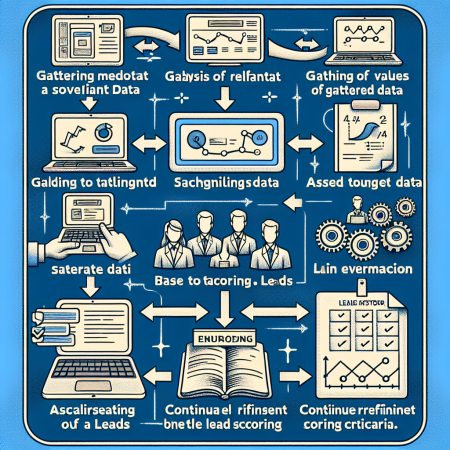How to Develop a Lead Scoring System
Section 1: Understanding Lead Scoring
Lead scoring is a crucial component of any successful marketing strategy. It involves assigning values to leads based on their behavior and engagement with your brand. By effectively scoring leads, you can prioritize and focus your efforts on those most likely to convert, ultimately increasing your ROI.
To develop a lead scoring system, start by defining your ideal customer profile. Understand the characteristics and behaviors that indicate a lead is likely to convert. This could include demographic information, online behaviors, engagement with your content, or past interactions with your brand.
Next, determine which actions or behaviors should result in a lead gaining or losing points. For example, opening an email might be worth a few points, while attending a webinar could be worth more. Conversely, if a lead unsubscribes from your mailing list, they might lose points.
Regularly review and adjust your lead scoring system based on the data and outcomes it produces. By analyzing the effectiveness of your scoring criteria and making necessary tweaks, you can ensure your system remains accurate and reflective of your target audience.
Section 2: Setting Up Your Lead Scoring Model
When setting up your lead scoring model, consider the different attributes and behaviors that are important indicators of a lead’s readiness to purchase. These could include website visits, form submissions, email interactions, social media engagement, and more.
Assign a point value to each of these actions based on their level of importance and relevance to your sales process. For example, a lead downloading a whitepaper might be worth more points than simply visiting your website’s homepage.
Define your scoring thresholds to determine when a lead moves from being a marketing lead to a sales-qualified lead. This step is crucial for ensuring that sales teams focus their efforts on leads that are most likely to convert into customers.
Integrate your lead scoring system with your customer relationship management (CRM) software to streamline the process and ensure seamless communication between marketing and sales teams. This will enable your teams to access lead scores and related data in real-time, facilitating better decision-making.
Section 3: Implementing Lead Scoring Automation
Implementing lead scoring automation can significantly streamline your marketing and sales processes. By leveraging marketing automation software, you can track and score leads in real-time based on their interactions with your brand.
Create lead scoring rules within your automation platform to automatically assign points to leads based on their behavior. This could include triggers such as email opens, link clicks, website visits, and more. Automation allows you to scale your lead scoring efforts efficiently and effectively.
Use lead scoring analytics to gain insights into the effectiveness of your scoring system. Monitor which actions correlate most strongly with lead conversion and adjust your scoring rules accordingly to optimize performance.
Regularly assess the accuracy of your automated lead scoring system and make refinements as needed to ensure that it continues to align with your evolving business goals and objectives.
Section 4: Leveraging Lead Scoring for Improved Conversions
Effectively leveraging lead scoring can lead to improved conversion rates and greater ROI for your marketing efforts. By focusing on leads that have demonstrated strong intent and interest in your products or services, you can tailor your messaging and offerings to better meet their needs.
Use lead scores to segment your leads into different nurture tracks based on their readiness to purchase. This allows you to deliver personalized content and offers that are more likely to resonate with each segment, increasing the likelihood of conversion.
Align your sales and marketing teams around your lead scoring system to ensure a cohesive approach to lead management. Share insights and data from your scoring system to help both teams understand where leads are in the buying journey and how they can best support them through the sales process.
Continuously monitor and analyze the performance of your lead scoring system to identify areas for improvement. By tracking key metrics such as conversion rates, lead velocity, and pipeline growth, you can refine your scoring model to achieve better results over time.
Section 5: Best Practices for Lead Scoring Success
When implementing a lead scoring system, consider these best practices to ensure success and maximize results:
Regularly communicate and collaborate with your sales team to gather feedback on lead quality and adjust scoring criteria accordingly. Sales input is invaluable for refining your scoring system based on real-world interactions with leads.
Monitor and analyze the performance of your lead scoring system on an ongoing basis to identify trends and patterns that can inform strategic decisions. Use this data to refine your scoring criteria and improve the overall effectiveness of your lead generation efforts.
Test different scoring models and criteria to determine what works best for your unique business and target audience. Experimentation is key to finding the optimal balance between lead quantity and lead quality, ultimately driving better results.
Regularly review and update your scoring rules to ensure they remain relevant and accurate in light of changing market dynamics, customer behaviors, and business goals. Flexibility and adaptability are essential for maintaining a successful lead scoring system in the long term.
Related Content
- The Unexpected Benefits of Working from Home
- Adapt quickly in uncertain conditions by prioritizing real-time data in 2025
- How to use WhatsApp to grow your business
- Increase personalization by referencing audience challenges and triumphs in messaging
- Attract consistent organic traffic by producing highly shareable video transcriptions in 2025

